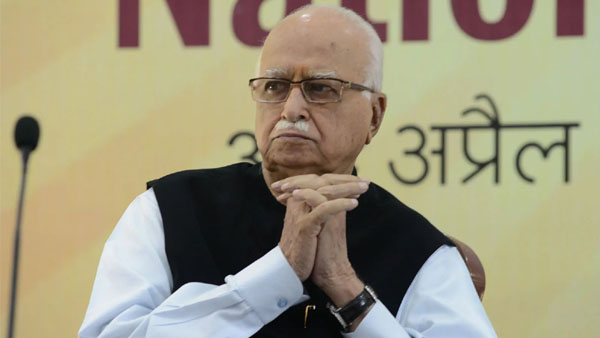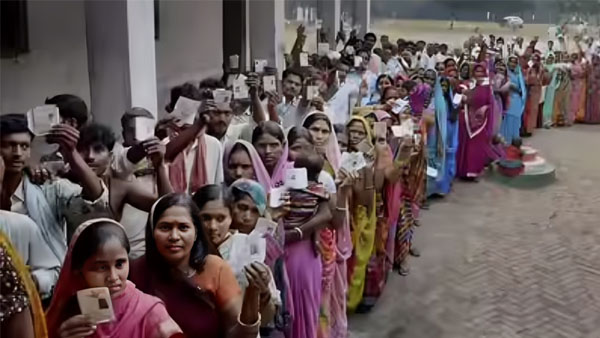By Dipak Kurmi
Indian politician and statesman Lal Krishna Advani stands as one of the most complex and paradoxical figures in the intricate tapestry of modern Indian political history. Few leaders have embodied the profound tension between unwavering ideological conviction and the demands of pragmatic governance as starkly as Advani. His remarkable journey from being the firebrand leader of the Ram Janmabhoomi movement, whose very name could mobilize millions across the nation, to a seasoned statesman advocating party unity and national cohesion represents one of the most significant political transformations in contemporary India. This evolution, often misunderstood and mischaracterized as mere opportunism by his critics and viewed as an unforgivable betrayal by hardline supporters who had once revered him, was in reality a sacrifice of monumental proportions. It was a deliberate and conscious choice, made with full awareness of its personal costs, to place national interest and party unity above personal legacy and ideological purity, demonstrating a maturity that is rarely witnessed in the unforgiving arena of Indian politics.
Advani’s most significant sacrifice came when he consciously distanced himself from the culmination of events surrounding the Babri edifice at Ayodhya. This decision, taken at a critical juncture in Indian political history, left the Hindu public disheartened and made his followers feel profoundly betrayed. Many accused him of abandoning the very cause that had catapulted him to national prominence, and for a leader with a conscience as sensitive as Advani’s, this accusation was akin to a self-inflicted wound. The pain of being misunderstood by those who had once followed him with unwavering devotion must have been excruciating, yet he bore it with stoic dignity, convinced that his choice served a higher purpose.
Reflecting on the spring of 1991, Advani candidly acknowledged that his national prominence was intricately linked to Ayodhya. Prior to leading the historic Rathyatra from Somnath in an ambitious attempt to reach what devotees considered the birthplace of Shri Ramchandra—a journey dramatically thwarted by Lalu Prasad Yadav at Samastipur in 1990—Advani was primarily recognized as a senior party figure, respected but not yet commanding the mass appeal that would later define his political career. The Rathyatra transformed him into a national icon, a leader who could mobilize millions, whose very presence could alter the political discourse of the nation. The imagery of Advani aboard that chariot became symbolic of Hindu assertion in the political sphere, galvanizing support that would eventually propel the BJP from the margins to the mainstream of Indian politics.
Yet, as events unfolded and the movement reached its controversial climax, Advani found himself at a critical crossroads. He proceeded to elaborate on his thinking during private conversations, emphasizing the paramount importance of maintaining party unity irrespective of circumstances. He acknowledged Atalji—Atal Bihari Vajpayee—as the senior-most leader and urged party members not to publicly dissent with him on matters of policy. This deference to Vajpayee was not merely protocol; it reflected Advani’s understanding that successful governance in India’s diverse democracy required a leader who could command acceptance across ideological and regional divides, qualities that Vajpayee possessed in abundance.
Advani posed critical questions that revealed the depth of his introspection regarding the breach of the party’s commitment to the Supreme Court regarding the safety of the edifice. He pondered the consequences with genuine anguish, questioning the potential erosion of faith in the words of BJP leaders if the party was seen as complicit in breaking solemn assurances given to the nation’s highest court. The unresolved fate of the structure, he insisted, rested in the hands of the court, highlighting his belief in constitutional processes even when they produced outcomes inconvenient to political ambitions. This stance demonstrated a mature understanding that democracy’s strength lies not in the fulfillment of every popular demand but in adherence to institutional norms and legal processes.
Furthermore, Advani was acutely aware that rival political parties would eagerly exploit any signs of internal division, portraying the BJP as a faction-ridden party unable to maintain cohesion among its leadership. The narrative could unfold with devastating effect—the juxtaposition of the top leader’s disapproval of what was dismissively termed “masjid-hunting” against the contrasting actions of party members who engaged in precisely such activities. This potential scenario raised serious apprehensions about the party’s image and coherence in the eyes of the discerning public. For a party that prided itself on discipline and ideological clarity, such contradictions threatened to undermine years of careful image-building.
Moreover, Advani articulated a foundational principle: that a principled political party is synonymous with unity, and the BJP’s identity had always been that of a distinctive party with clear ideological moorings. Deteriorating into a party marked by internal factions contradicted the very essence of what made the BJP unique in India’s political landscape. Equally crucial was the fact that discipline had consistently defined the party’s character since its inception. This raised uncomfortable questions that Advani did not shy away from confronting: Did the karsevaks at Ayodhya exhibit the disciplined conduct that the party claimed to exemplify when they defied leadership directives and demolished a place of worship belonging to another community? The answer, painful as it was, suggested a failure of organizational control that had profound implications for the party’s credibility.
By April 1998, when Advani facilitated the author’s entry into the Rajya Sabha through a bye-election, there was a noticeable decline in interest regarding Ayodhya among party members. The case lingered in court without active proceedings, seemingly in perpetual limbo. Contemplating the absence of the once-standing structure, questions arose about whether the Congress party, if led by a shrewd strategist, might seize the opportunity to wrest the issue from the BJP’s grasp and leverage it for electoral gains. The enduring popularity of the matter, which continued to manifest itself repeatedly in public discourse, made it a potent political weapon that could cut both ways.
During this transitional period, an increasing number of pilgrims made their way to the sacred city, demonstrating that whatever the political machinations, the religious significance of the site remained undiminished for millions of devotees. In July 1999, Advani extended an invitation for a discussion over toast and coffee in his Parliament House room, a setting that facilitated frank exchanges away from public scrutiny. In the course of that conversation, he commended Vajpayee’s adept leadership in managing a coalition comprising diverse parties with varying, often contradictory, political ideologies, spanning the ideological spectrum from the Shiv Sena to the DMK.
Undoubtedly, Vajpayee had skillfully navigated the complexities of coalition governance, leading a diverse alliance with remarkable success despite its inherent contradictions. Advani lauded his leadership, emphasizing that any future leader would need to command the same level of widespread acceptance and loyalty that Atalji effortlessly garnered across party lines and regional identities. According to Advani, such qualities were indispensable for effectively steering a diverse nation like India, where regional, linguistic, religious, and caste identities created a political landscape of extraordinary complexity.
Advani’s vision extended beyond immediate political considerations. He expressed the conviction that members within the party ought to set aside minor differences and focus on overarching policy matters that affected the nation’s trajectory. By doing so, he believed, a leader and their party would naturally draw votes and cultivate a sustained following based on governance and vision rather than divisive rhetoric. This represented a significant evolution in thinking for someone who had once been the face of Hindu political assertion.
Continuing his thoughts, Advani expressed a profound conviction that the future of India hinged on the integrity of its politics. Rather than advocating a move towards what critics might dismiss as moderation or ‘soft secularism,’ he emphasized the crucial need for unity in thought, policy, and leadership. Implicitly, he was calling for a cohesive party led by a broadminded leader capable of transcending narrow sectarian considerations. His emphasis remained consistently on the importance of fostering unity among different factions within parties, rather than merely focusing on superficial organizational unity that masked deeper ideological divisions.
While dynastic parties also grappled with internal factions and fractures, often kept hidden behind family loyalty, the BJP stood out as the exception, successfully steering clear of such divisions through ideological commitment and organizational discipline. It appeared as if Advani was contemplating a departure from his previous stances, seemingly inclined to embrace a new cause that transcended the religious nationalism that had defined his earlier career. This shift was not merely for the electoral benefit of the BJP but seemed driven by a genuine commitment to the long-term well-being of the country, a recognition that India’s diversity required political accommodation rather than confrontation.
From close observation of Advani’s journey, one can confidently assert that his transformation was not merely a tactical shift in perspective but a profound sacrifice of personal ambition and ideological consistency. Transitioning from fervently denouncing what he had termed pseudo-secularism to advocating for pan-India moderation and consensual politics, it appeared as though Advani had consciously relinquished his past convictions for the betterment of both the BJP and the nation as a whole. This was not the cynical abandonment of principles that critics alleged but rather a mature recognition that governing a complex democracy required different qualities than mobilizing mass movements.
Undoubtedly, this transition must have posed significant personal and psychological challenges for Advani. To be viewed as having betrayed a cause that had defined one’s political identity, to face the disappointment of devoted followers who felt abandoned, to endure accusations of opportunism when one believed oneself to be acting from principle—these were burdens that would test any leader’s resolve. Yet, Advani bore them because he understood what many of his critics did not: that true leadership sometimes requires sacrificing one’s image and legacy for outcomes that may only be appreciated by history.
The evolution of Advani from movement leader to statesman represents a pattern repeated throughout democratic history—the recognition that mobilization and governance require fundamentally different approaches. Movements thrive on clear binaries, on the energy generated by opposition, on the mobilization of identity and grievance. Governance, particularly in diverse democracies, requires accommodation, compromise, coalition-building, and the patient navigation of competing interests. The transition from one to the other is never easy, and those who successfully make it often find themselves attacked from both sides—by former allies who view them as sellouts and by opponents who refuse to forget their earlier positions.
Advani’s sacrifice ultimately underscored his unwavering commitment to what he perceived as the greater good—a stable, unified party capable of governing India effectively, respecting constitutional norms while remaining true to its foundational philosophy. Whether history will judge this transformation as wisdom or weakness remains to be seen, but there can be no doubt about the personal cost Advani paid for choosing pragmatism over ideological purity. In an era of increasingly strident politics where compromise is often portrayed as betrayal and nuance as confusion, Advani’s journey offers a sobering reminder that leadership in a democracy sometimes requires the courage to disappoint one’s supporters, the wisdom to recognize when causes must yield to institutional stability, and the maturity to place party and nation above personal legacy. That remains his most enduring, if least celebrated, contribution to Indian political life.
(the writer can be reached at dipakkurmiglpltd@gmail.com)




